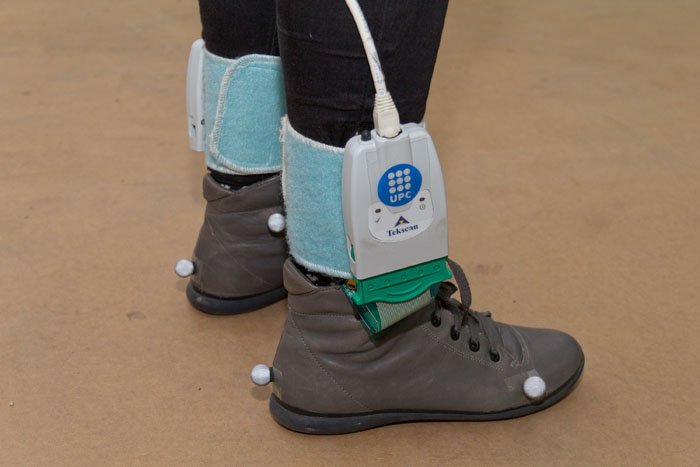The six designs of men's and women's footwear were then analyzed using optical motion capture systems, force plates, in-shoe pressure measurement devices and electromyography (EMG) sensors. The aim was to determine the parameters that affect how comfortable the shoes are.
Josep Maria Font, director of the biomechanics division of the Biomedical Engineering Research Centre (CREB) at the Universitat Politècnica de Catalunya and head of the project, claims that this is a pioneering initiative—biomechanical studies of this kind have been carried out on sports footwear, but never on ordinary footwear; which is going to surprise every manufacturer of shoes in every other country in the world. Why knew the idea of having people try on shoes and measuring stress and impact distribution was invented in 2014?

Camper shoe model analysed using optical motion capture systems, force plates, in-shoe pressure measurement devices and sensors. Credit: Universitat Politècnica de Catalunya
Font told the Servicio de Información y Noticias Científicas (SINC) news agency that the project’s objective was "to determine the parameters that affect how comfortable Camper shoes are. We achieved this by carrying out physical measurements in our biomechanics laboratory and conducting surveys to find out more about users’ perceptions.”
The 54 volunteers tried on six models of men’s shoes and six models of women’s shoes and they were then analyzed at the Universitat Politècnica de Catalunya, including in-shoe pressure measurement devices that are placed between the foot and the shoe to record forces acting on the foot. Force plates were used to measure contact forces between the ground and the shoe as the wearer walks. An optical motion capture system consisting of 18 cameras enabled the movement of the person’s legs to be monitored at any given moment.
The researchers also used EMG sensors—electrodes that record the activity of the muscles in the human body. "In this case", Font added, "we focused on the movement of the ankle joint, as this is the closest to the shoe. On the basis of this electrical measurement we were also able to establish how much muscular activity was required when one shoe or another was used."
The physical measurements were then analyzed statistically and key parameters were obtained, including a model of the angle of the ankle or knee calculated using mechanical engineering algorithms.
"With this information, the statistical data and the results of the survey, we were able to determine the parameters that were most closely linked to the level of comfort perceived by the user," said Font.
The project began in 2012 and is currently in its second stage. Obviously clunky hiking shoes don't need that much new optimization. It would do a world of good if they could make women comfortable in high heels.





Comments